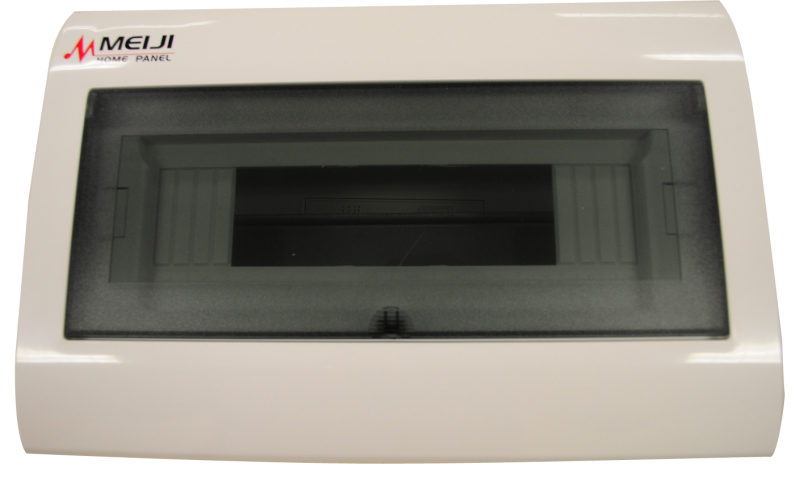What factors do you need to consider when it comes to choosing between plastic and metal home panel boards?
- Grounding
- Durability
- Installation
- Cost
A panel board, also often called distribution board, is an element of the electrical system that has the primary function of dividing the electrical power feed into supplementary circuits. In addition, it provides a shielding or a protective fuse/circuit breaker for each circuit in a single enclosure. If you go to your local electrical supplier in Metro Manila, you’re sure to find panel boards equipped with different components and in a wide variety of shapes.
Oftentimes, it is made up of several electrical components such as the main switch, fuse links, bus bars, switches, and bypass equipment. There are also those that are incorporated with one or more residual-current devices (RCD) and/or residual current breakers with overcurrent protection (RCBO). While these panel boards can be categorized based on the components they carry, it is more common for them to be divided according to their enclosure.
There are two main types of panel board enclosure – plastic and metal. Admittedly, most distribution boards installed in houses – also known as consumer units – are often made from sheet metal. However, plastic home panel board enclosures have entered the market and are proving to be able competitors. People are now torn between these two types and are often stumped when forced to decide between them.
If you’re in a similar position, we highly suggest you continue reading as we pit these two types against each other and find out which comes out on top!
Grounding
As someone who isn’t well-versed in handling electrical systems, the concept of grounding may be lost to you – like it is in many people – so we’ll briefly explain what it is. To put it simply, grounding is a safety measure that is used to protect people from accidentally coming in contact with electrical hazards. It involves creating a backup pathway for the current to flow into in case something goes wrong with the system, essentially lowering the risk of electrocution and other electrical damage.
At this point in time, grounding has become a necessity and is being done to all electrical systems that have a metallic surface, which may include your panel board. Since metal is conductive in nature, it is important that these systems must be grounded.
Plastic enclosures are non-conductive and don’t necessarily have to be grounded despite housing large electrical circuits. Although it is ideal for safety, it can be skipped completely if you go for a plastic home panel board.
Durability
Metal home panel boards are usually made from American standard steel which is known to be tough and durable. They are designed to last for a long time and can withstand heavy wear and tear. It would take a lot of power to scratch, dent, and completely destroy these metal enclosures.
Plastic home panel boards can also be considered durable especially those made from polycarbonate plastic – a material used to make signboards, machine guards, face shields, skylights, and more. It can withstand a significant amount of wear and tear, but it’s undeniable that it is slightly lacking when compared to metal panel boards.
When up against the forces of nature (i.e. weather), there is a chance for plastic to swell up and get deformed and, unfortunately, there’s no countering this problem. Metal, on the other hand, needs to fight against rust, but you can easily sidestep this by going for a metal enclosure that is coated in aluminum.
Installation
Plastic, without a doubt, is the easier one to install because it is significantly lighter and easier to handle. With proper guidance and while observing safety precautions, you could successfully install a plastic home panel board by yourself. Due to their lightweight, you can effortlessly lift and transfer the part from one place to another. On top of this, they aren’t as bulky, making them beneficial for special, small, and complex applications.
Metal home panel boards are as heavy as they sound and look; you’re going to need an extra pair of hands if you want them installed properly. Typically, you should ask the help of a professional because as said earlier, there is the matter of grounding the metal panel board.
Although both should be installed by professionals, it isn’t unusual for plastic panel board installation to be done DIY-style. Metal panel board installation, on the other hand, requires an extra set of hands – more often that of a professional’s.
Cost
While there isn’t much of a price difference, there is no denying that plastic is the cheaper choice between the two. Plastic, after all, is the most cost-effective and economical material available in the market. Moreover, you can further reduce cost by doing DIY installation and removing the need for grounding.
However, you have to take into account the pros that you can get from installing a metal home panel board. For the most part, they are considered more durable and offer more protection against the weather, which could be crucial depending on where you live.
When it comes to cost, you can say that plastic is the cheaper option, but that doesn’t automatically mean that it is the better one. You have to consider other factors in the cost of the panel board before you can truly decide which is worth your money.
Key Takeaway
At the end of the day, both types – with their own set of advantages and disadvantages – are sure to serve their purpose in the best way possible. The best one for your home ultimately depends on your situation and surroundings. Once you’ve arrived at a logical and well-informed decision, you can then head to your trusted electrical supplier in Metro Manila and purchase the home panel board of your choice!

